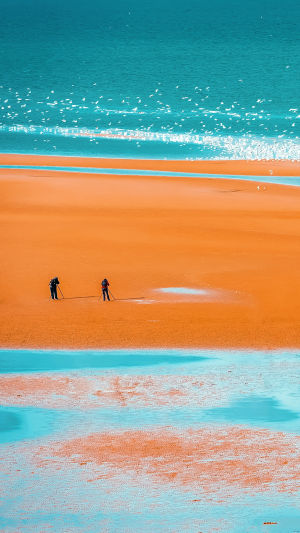You have seen the mountains and the sea, you have walked on the waves or in the desert, but you may have overlooked the muddy mudflats under your feet!
The mudflats, an "invisible paradise" between the sea and the land are rich in species resources, but suffer from high salinity "torture", and urgently need your attention and protection!
The mudflats are the tidal inundation zone between the high and low tide levels along the coast.
Due to the tidal action, the mudflats are sometimes submerged by water and sometimes exposed to the water.
It is one of the most vibrant parts of the earth's ecosystem as it has both marine and terrestrial ecosystem characteristics, with plants and animals as well as soil, water, and other environmental factors having the dual properties of both marine and terrestrial environments, and is influenced by both terrestrial and marine environments.
Whether it is organic matter brought by surface or subsurface runoff, or nutrients from the ocean brought by the ebb and flow of the tide, they are constantly pooled and deposited in the mudflats.
These nutrients are difficult to use by species with higher trophic relationships, and a wide variety of benthic animals play a vital role in helping to circulate these nutrients.
When the tide went out, many small crabs came out of the mud and moved around.
On the surface, it looks like they are not doing anything, but if you look closely, you will see that they are actually taking the mud.
However, the fact is that these crabs are not really eating the mud, but putting it into their mouths and filtering out the organic matter such as algae and plankton, and then throwing the mud away.
The seemingly small action is to accumulate the nutrients in the mud into their own bodies for growth and development.
These small crabs are then predated by large predators such as birds, which is to pass the nutrients to a higher level of trophic relationship.
In addition to this, many mudflat crabs live in the mud of the mudflats and their burrowing behavior can help unclog the deep mud and allow fresh air or water to reach here, which is vital for the plants that grow on the mudflats (such as mangroves, etc).
The crabs living in the mudflats are mainly species of the family Sagittariidae and the general family of sand crabs, and the common ones include the arc-edge beckoning tide crab, the short-bodied bigeye crab, the Steller's new swell crab, the short-fingered monk crab, and the Taiwanese mud crab.
It is hard to imagine that these small and insignificant crabs have such an important role in the ecosystem of the mudflats.
Dongtai Striped Mud Wetland Conservation Area.
This wetland was inscribed on the UNESCO World Heritage List, and all eyes were on it for a while.
Without the fine sandy beaches and turquoise blue water, what makes this muddy and even somewhat insignificant mudflat win the respect of the world?
Because this mudflat connects the past with the future.
Back in the Pleistocene, two million years ago, there were several large rivers like the Yellow and Yangtze rivers in the eastern part of the Asian continent.
They rushed and meandered for thousands of kilometers, transporting sediment and nutrients from as far as the Tibetan Plateau and the deserts of Central Asia to these waters.
They nourish the communities of many species and ignite the star fires of civilization.
With the expansion of human civilization and the disappearance of marsh wetlands, this species was once extinct, but in the 1980s, with the growth of the artificial population of elk and the protection of the coastal wetlands of Yancheng.
This group of animals that had gone through hardships returned to the homeland where they had lived for generations.
And this mudflat connects China with the world.





